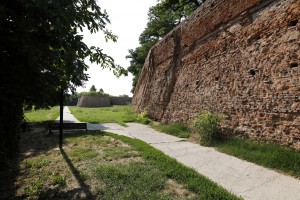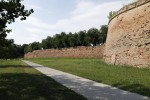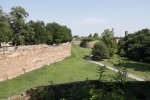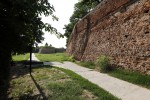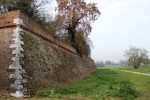Borso d'Este's ‘new walls’
Still standing between the mighty spade-shaped bastions built in the late sixteenth century, these curtain walls were built to the mid-fifteenth century, identified by the unmistakable red brick masonry and the countless putlog holes.
Historical notes
The gradual drying up of the Po tributary which skirts the southern edge of Ferrara (in the riverbed which corresponds with today’s Via della Ghiara and Via XX Settembre roads) led to the establishment of the urban settlement on the island of Sant’Antonio in Polesine, which once stood in the middle of the river, between the end of the fourteenth and the first half of the fifteenth century. Marquis Nicolò III d'Este (1383-1441) was responsible for taking the first steps to build a defence system for the urban settlement. This included the extension of the eastern walls up to the Po River (commissioning the curtain walls and the Porta del Barbacane) and the construction of the Castel Nuovo (literally ‘New Castle’) to the south-west (in the area where the Teatro Verdi theatre currently stands) in 1425-28, overseen by an engineer named Giovanni da Siena. Between 1562 and 1572, this fortress was later demolished to make room for the Baluardo di San Lorenzo (Bastion of San Lorenzo).
Around 1438, the decision was made to expand the city to the south, in the area known as the Polesine di Sant’Antonio. Thus the area was enveloped with a new section of walls and building it around the main street (Via della Ghiara), crossed by some perpendicular roads that demarcated the blocks, connecting them organically to the old centre of the city. The further drying up of the Po River led Leonello d'Este (1407-1450) and above all his successor Borso (1413-1471) to order new walls to be built to protect the entire area between Castel Nuovo and the Barbacane di San Giorgio (Barbican of Saint George) to the south-east, entrusting the construction of these walls to the architect Pietrobono Brasavola in 1442, who was succeeded by Cristoforo della Carradora, Benvenuto dagli Ordini and his son Pietro. In 1451, along the Mura Nuove (New Walls), the three gateways of Porta San Pietro, Porta dell'Amore and Porta San Giorgio were constructed, before being walled up and/or modified in the following two centuries.
Once painted with crenellations, the red, rectilinear curtain walls built under Borso d’Este still feature many putlog holes. These holes where made intentionally in the wall to hold scaffolding beams used to complete the construction of particularly tall buildings. To create them, all they had to do was replace a few masonry stones with the ends of a wooden beams, which ended up becoming part of the wall. They were later removed, leaving a hole (which was then sometimes filled in).
The walls built by Borso d’Este still have their escarp base and large portions of the interlocking brick bond beam, just as in some points the walls one can make out traces of tall, squared towers, knocked down in the late sixteenth century. On one of the three silver plates that covered the bronze ark (a sort of chest) holding the relics of Saint Maurelio (today kept in the Basilica of Saint George), Giannantonio Leli of Foligno engraved a scene depicting the prior of the Olivetano Order appearing before the saint in the church of Saint George, using the Borsian curtain wall with the towers as it appeared around 1512 as the background on the left-hand side: a truly captivating ‘photograph’.
According to some historians living around that time, work on the ‘Borso Addition’ ended in autumn of 1466, when ‘the Polesine di Sant’Antonio was pulled within Ferrara and all of the people who lived in Polesine were made citizens in consideration of the new walls’. Thus, the residents of this area became, for all intents and purposes, citizens of the city, no longer mere dwellers of a hamlet.
Bibliography
- Anna Maria Visser Travagli, Il contributo dell'archeologia al restauro delle Mura di Ferrara, in Maria Rosaria Di Fabio (a cura di), Le Mura di Ferrara. Storia di un restauro, Minerva, Bologna 2003
- Francesco Scafuri, Le mura di Ferrara. Un itinerario attorno alla città, tra storia ed architettura militare, in Maria Rosaria Di Fabio (a cura di), Le mura di Ferrara. Storia di un restauro, Minerva, Bologna 2003
- Marco Folin, Un ampliamento urbano della prima età moderna: l'Addizione erculea di Ferrara, in Marco Folin (a cura di), Sistole/diastole. Episodi di trasformazione urbana nell'Italia delle città, Venezia 2006
- Marco Zuppiroli, Ferrara: mura civiche e trasformazioni urbane tra XIII e XV secolo, in Riccardo Dalla Negra, Alessandro Ippoliti, La città di Ferrara: architettura e restauro, Ginevra Bentivoglio Editoria, Roma 2014
Fototeca
Related Themes
Compiling entity
- Assessorato alla Cultura e al Turismo, Comune di Ferrara

